Eco-friendly home design offers long-term benefits such as reduced energy costs and improved health. This approach emphasizes sustainable materials, energy efficiency, and innovative practices. Key elements include using bamboo, reclaimed wood, and energy-efficient appliances. Additionally, incorporating natural light and smart technologies enhances comfort and reduces environmental impact.
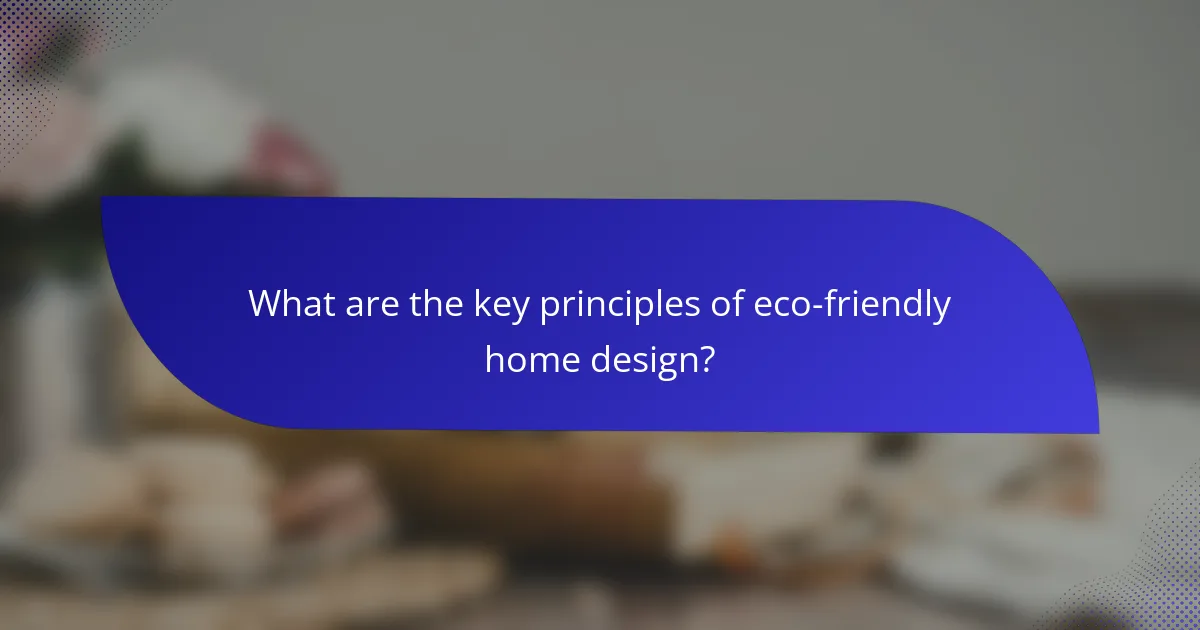
What are the key principles of eco-friendly home design?
Key principles of eco-friendly home design include using sustainable materials, maximizing energy efficiency, and promoting water conservation. These practices minimize environmental impact and enhance indoor air quality.
Sustainable materials such as bamboo, reclaimed wood, and recycled metals reduce resource depletion. Energy-efficient appliances and insulation lower utility costs and carbon footprints. Water-saving fixtures and rainwater harvesting systems further contribute to sustainability.
Incorporating natural light through strategic window placement enhances comfort and reduces reliance on artificial lighting. Green roofs and landscaping with native plants support biodiversity and improve air quality.
Overall, eco-friendly home design prioritizes environmental responsibility while creating healthy living spaces.
How do sustainable materials contribute to eco-friendly design?
Sustainable materials enhance eco-friendly design by minimizing environmental impact and promoting resource efficiency. They reduce waste, lower carbon emissions, and often utilize renewable resources. For example, bamboo is a rapidly renewable material that absorbs carbon dioxide during growth. Recycled materials, such as reclaimed wood, contribute to reducing landfill waste while providing unique aesthetic qualities. Additionally, sustainable materials often have a longer lifespan, which decreases the need for frequent replacements, further benefiting the environment.
Why is energy efficiency important in home design?
Energy efficiency is crucial in home design because it reduces energy consumption and lowers utility costs. Sustainable materials and practices enhance this efficiency, promoting environmental conservation. Energy-efficient homes often utilize insulation, energy-saving appliances, and renewable energy sources. As a result, they contribute to a reduced carbon footprint and improved indoor comfort. Energy-efficient designs can increase property value and appeal to eco-conscious buyers.
How can natural lighting enhance sustainability?
Natural lighting significantly enhances sustainability by reducing energy consumption and improving indoor air quality. It decreases reliance on artificial lighting, thereby lowering electricity bills and carbon footprints. Utilizing large windows and skylights allows natural light to illuminate spaces, fostering a connection with the outdoors. This design approach not only benefits the environment but also enhances occupants’ well-being by providing natural circadian rhythms. Incorporating energy-efficient materials alongside natural lighting can result in a more sustainable and eco-friendly home.
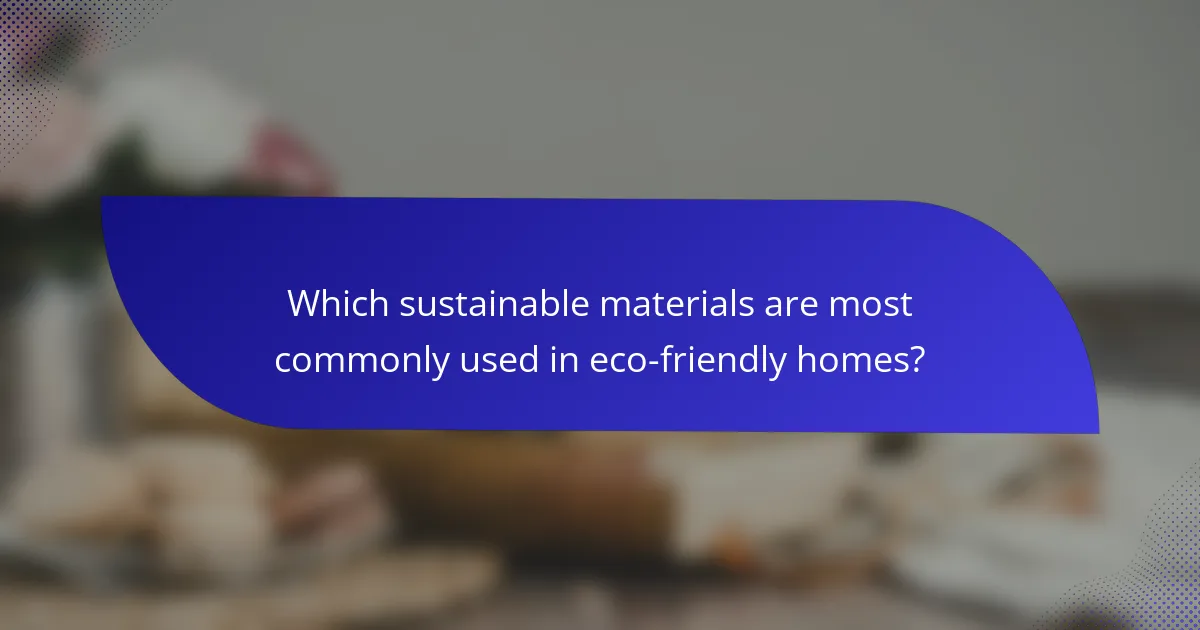
Which sustainable materials are most commonly used in eco-friendly homes?
Commonly used sustainable materials in eco-friendly homes include bamboo, reclaimed wood, recycled metal, straw bales, and rammed earth. These materials offer durability, low environmental impact, and energy efficiency. Bamboo is rapidly renewable, while reclaimed wood reduces waste. Recycled metal is durable and minimizes resource extraction. Straw bales provide excellent insulation, and rammed earth is a natural building technique with thermal mass benefits. Each material contributes to sustainable construction practices and enhances eco-friendly home design.
What are the benefits of bamboo as a building material?
Bamboo offers numerous benefits as a building material, making it an ideal choice for eco-friendly home design. It is sustainable, rapidly renewable, and has a high strength-to-weight ratio, which allows for sturdy structures. Bamboo also sequesters carbon, contributing to lower greenhouse gas emissions. Its natural resistance to pests reduces the need for chemical treatments. Additionally, bamboo’s flexibility makes it suitable for various architectural styles, enhancing aesthetic appeal.
How does recycled metal contribute to sustainability?
Recycled metal significantly enhances sustainability by reducing resource extraction and energy consumption. Using recycled materials lowers greenhouse gas emissions and minimizes landfill waste. For instance, recycling aluminum saves 90% of the energy required to produce new aluminum. This practice not only conserves natural resources but also promotes a circular economy. As a result, incorporating recycled metal into eco-friendly home design supports sustainable living and reduces environmental impact.
Why is reclaimed wood a popular choice for eco-friendly design?
Reclaimed wood is popular for eco-friendly design due to its sustainability and unique aesthetic. This material reduces waste by repurposing old wood, which minimizes deforestation. It offers distinct character, showcasing imperfections and history. Reclaimed wood contributes to carbon footprint reduction, making it a preferred choice among environmentally conscious designers. Its versatility allows for various applications, from flooring to furniture, enhancing both functionality and style in sustainable homes.

What innovative practices are emerging in sustainable home design?
Innovative practices in sustainable home design focus on energy efficiency, renewable materials, and smart technology integration. These practices include using recycled materials, implementing passive solar design, and incorporating green roofs. Energy-efficient appliances and smart home systems optimize resource use, reducing carbon footprints. Additionally, biophilic design principles enhance well-being by connecting occupants with nature.
How can green roofs improve energy efficiency?
Green roofs significantly enhance energy efficiency by providing insulation and reducing heat absorption. They lower indoor temperatures, decreasing reliance on air conditioning. Studies show that buildings with green roofs can reduce energy costs by up to 25%. Additionally, they mitigate urban heat island effects, improving overall city energy performance. Green roofs also promote biodiversity, contributing to a healthier ecosystem.
What role do passive solar techniques play in home design?
Passive solar techniques are essential in eco-friendly home design as they harness natural sunlight for heating and lighting. These methods reduce energy consumption and lower utility costs by optimizing building orientation, window placement, and thermal mass materials. For instance, south-facing windows maximize solar gain in winter while minimizing it in summer. Incorporating these techniques can lead to a 30% reduction in heating costs, making homes more sustainable. Additionally, using materials like concrete and stone enhances thermal mass, storing heat during the day and releasing it at night.
How does water conservation influence design choices?
Water conservation significantly influences design choices in eco-friendly home design. Sustainable practices prioritize materials and methods that minimize water usage and promote efficiency.
Designers often select drought-resistant landscaping to reduce irrigation needs. Additionally, water-efficient fixtures, such as low-flow faucets and dual-flush toilets, are standard choices. Incorporating rainwater harvesting systems further enhances sustainability by utilizing natural resources.
The use of permeable materials in driveways and walkways allows for better water absorption, reducing runoff. These design choices not only conserve water but also contribute to the overall eco-friendliness of the home.
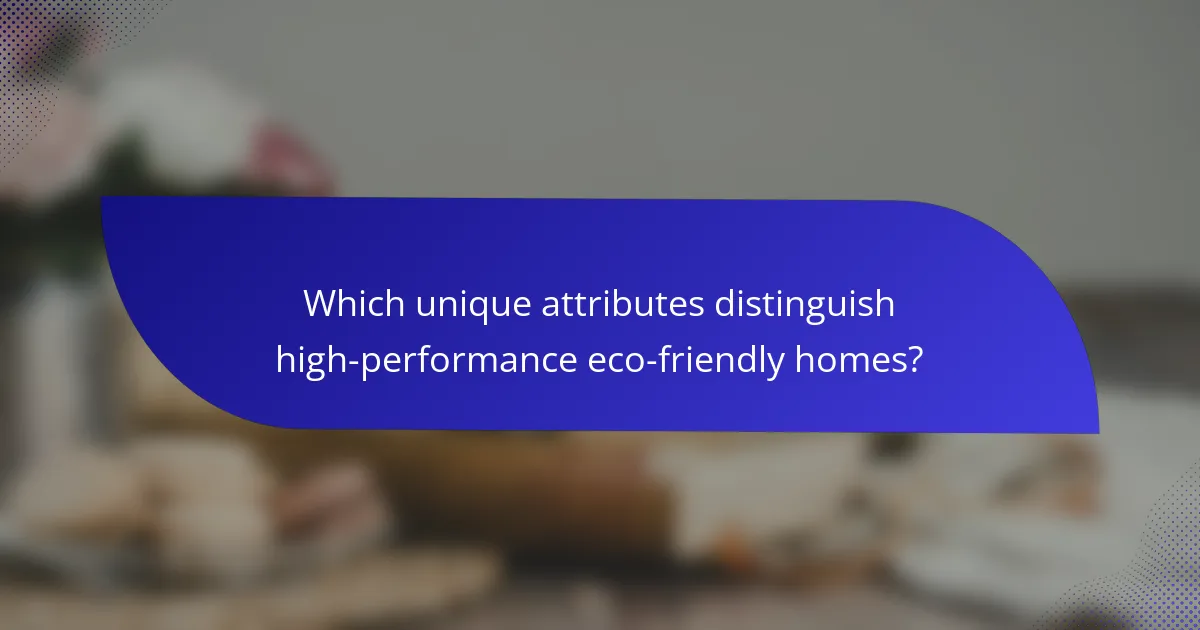
Which unique attributes distinguish high-performance eco-friendly homes?
High-performance eco-friendly homes are distinguished by their energy efficiency, sustainable materials, and innovative design. These homes often feature renewable energy systems, such as solar panels, which provide a unique attribute of energy independence. Additionally, the use of recycled or locally sourced materials enhances sustainability, reducing the carbon footprint. Advanced insulation techniques improve thermal performance, a rare attribute that contributes to lower energy consumption. Finally, smart home technologies optimize resource use, making these homes not only eco-friendly but also highly functional.
What advanced technologies are integrated into smart eco-friendly homes?
Smart eco-friendly homes integrate advanced technologies such as solar panels, smart thermostats, and energy-efficient appliances. These technologies enhance sustainability and reduce energy consumption.
Solar panels convert sunlight into electricity, promoting renewable energy use. Smart thermostats optimize heating and cooling, adjusting based on occupancy patterns. Energy-efficient appliances minimize power usage, contributing to lower utility bills.
Additionally, smart home systems allow for remote monitoring and control of energy consumption. This integration supports a sustainable lifestyle while offering convenience and cost savings.
The combination of these technologies exemplifies the unique attributes of eco-friendly home design, leading to a more sustainable future.
How do zero-energy homes function?
Zero-energy homes function by generating as much energy as they consume over a year. They utilize renewable energy sources, primarily solar panels, to produce electricity. Energy-efficient designs minimize consumption through high-quality insulation, energy-efficient appliances, and smart home technologies. These homes often incorporate sustainable materials, enhancing their eco-friendly attributes. As a result, they significantly reduce carbon footprints and promote sustainable living practices.
What are the features of homes designed for maximum sustainability?
Eco-friendly homes feature sustainable materials and practices that minimize environmental impact. Key aspects include energy efficiency, renewable energy sources, water conservation systems, and the use of non-toxic materials. These elements contribute to a healthier living environment and lower utility costs.
Energy-efficient designs often incorporate insulation, energy-efficient windows, and smart home technology to reduce energy consumption. Renewable energy sources, such as solar panels or wind turbines, provide clean energy alternatives. Water conservation systems, including rainwater harvesting and greywater recycling, enhance sustainability. Non-toxic materials, like bamboo flooring and low-VOC paints, ensure indoor air quality.
Incorporating these features can significantly reduce a home’s carbon footprint while promoting a sustainable lifestyle. By focusing on these attributes, homeowners can create spaces that are both environmentally friendly and economically viable.
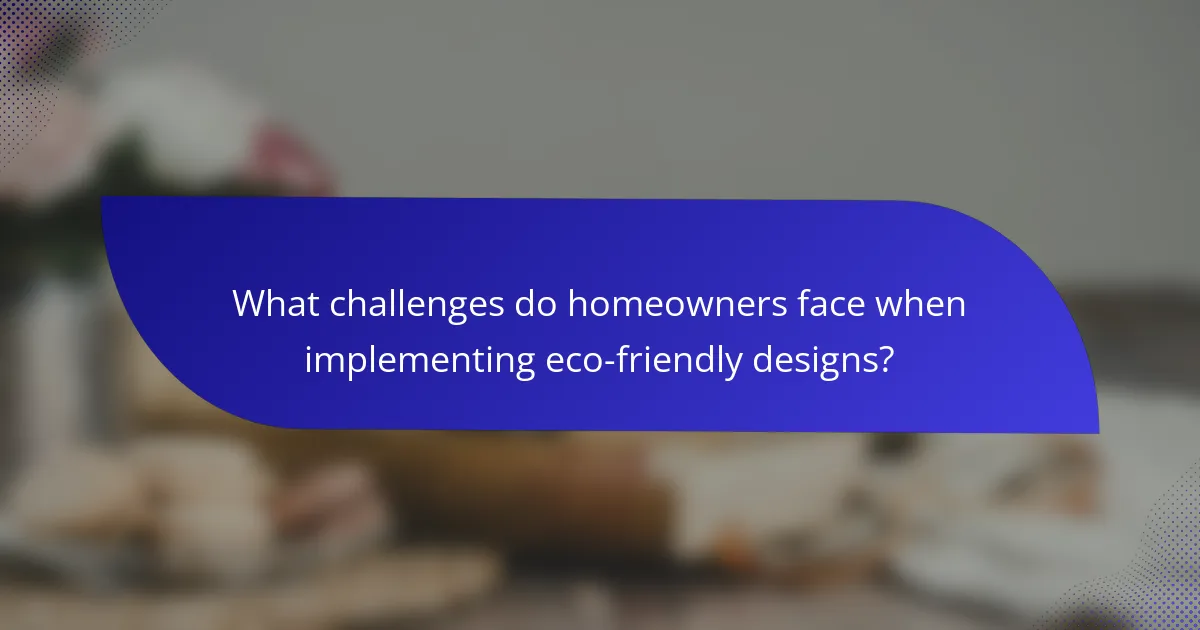
What challenges do homeowners face when implementing eco-friendly designs?
Homeowners face several challenges when implementing eco-friendly designs. High initial costs for sustainable materials can deter investment. Limited availability of eco-friendly products in certain regions complicates sourcing. Additionally, navigating building codes and regulations for green designs can be confusing. Homeowners may also encounter resistance from contractors unfamiliar with sustainable practices. Finally, the lack of information on long-term benefits can lead to skepticism about eco-friendly choices.
How can budget constraints impact sustainable choices?
Budget constraints can limit sustainable choices in eco-friendly home design. Limited funds often lead homeowners to prioritize cost over environmental impact, resulting in the use of cheaper, less sustainable materials. For example, opting for standard insulation instead of eco-friendly alternatives can save money but increase energy consumption. Additionally, budget limits may restrict investment in renewable energy sources, like solar panels, which offer long-term savings and environmental benefits. As a result, achieving a balance between affordability and sustainability becomes challenging, often compromising the overall eco-friendliness of the home design.
What are common misconceptions about eco-friendly materials?
Common misconceptions about eco-friendly materials include the belief that they are always more expensive, less durable, or less effective than traditional options. In reality, many sustainable materials offer comparable performance and cost savings over time. For instance, bamboo is often cheaper and more durable than hardwood. Additionally, some people think eco-friendly materials lack variety; however, the market now includes a wide range of stylish options. Lastly, there’s a misconception that all eco-friendly products are made from recycled materials, while many are sourced sustainably without recycling.
How does local climate influence material selection?
Local climate significantly influences material selection in eco-friendly home design. Factors such as temperature, humidity, and precipitation dictate the durability and performance of materials. For instance, in hot climates, materials with high thermal mass, like concrete, help regulate indoor temperatures. Conversely, in humid areas, moisture-resistant materials, such as treated wood or fiber cement, are preferable to prevent rot and mold. Additionally, local availability of sustainable materials can further guide choices, promoting reduced transportation emissions. Ultimately, aligning material selection with climate conditions enhances energy efficiency and sustainability in home design.
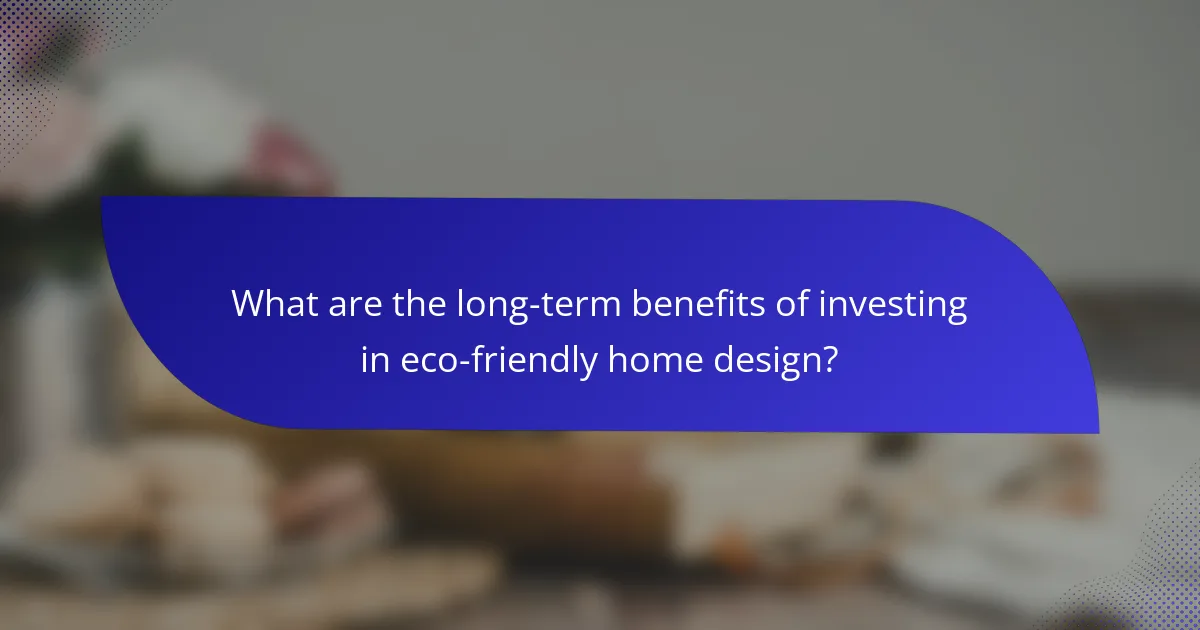
What are the long-term benefits of investing in eco-friendly home design?
Investing in eco-friendly home design offers long-term benefits such as reduced energy costs, improved health, and increased property value. Sustainable materials and practices lead to lower utility bills, as energy-efficient designs minimize consumption. Health benefits arise from better indoor air quality due to non-toxic materials and proper ventilation. Furthermore, homes designed with eco-friendly features often appreciate in value, attracting environmentally conscious buyers. This investment supports a sustainable lifestyle while enhancing comfort and well-being.
How does sustainable design affect property value?
Sustainable design positively affects property value by enhancing energy efficiency and reducing environmental impact. Eco-friendly materials and practices often lead to lower utility costs, making properties more attractive to buyers. Additionally, homes with sustainable features typically appreciate faster and have higher resale values. Research shows that properties designed with sustainability in mind can command up to 10% more than conventional homes, reflecting growing consumer demand for green living options.
What impact does eco-friendly design have on health and well-being?
Eco-friendly design positively impacts health and well-being by promoting cleaner air, reducing stress, and enhancing comfort. Sustainable materials, like low-VOC paints and natural fibers, minimize indoor pollutants. Biophilic design incorporates nature, improving mood and productivity. Research shows that green spaces and natural light boost mental health, leading to a more harmonious living environment.
How can eco-friendly homes contribute to community sustainability?
Eco-friendly homes significantly enhance community sustainability by reducing environmental impact and promoting resource efficiency. These homes utilize sustainable materials, such as bamboo and recycled steel, which lower carbon footprints. Additionally, energy-efficient practices, like solar panels and rainwater harvesting, contribute to local resource conservation. As a result, eco-friendly homes foster healthier living environments and encourage community engagement in sustainability initiatives.
What practical tips can homeowners follow to enhance sustainability?
Homeowners can enhance sustainability by adopting eco-friendly materials and practices. Start with energy-efficient appliances that reduce consumption and lower bills. Utilize sustainable materials like bamboo or reclaimed wood for construction and furnishings. Implement proper insulation to minimize energy loss. Consider rainwater harvesting systems to conserve water. Lastly, incorporate native landscaping to support local ecosystems and reduce maintenance.